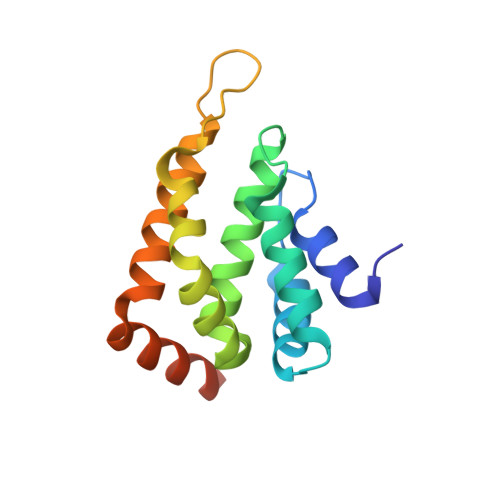A SNARE-adaptor interaction is a new mode of cargo recognition in clathrin-coated vesicles.
Miller, S.E., Collins, B.M., McCoy, A.J., Robinson, M.S., Owen, D.J.(2007) Nature 450: 570-574
- PubMed: 18033301
- DOI: https://doi.org/10.1038/nature06353
- Primary Citation of Related Structures:
2QY7, 2QYW, 2V8S - PubMed Abstract:
Soluble NSF attachment protein receptors (SNAREs) are type II transmembrane proteins that have critical roles in providing the specificity and energy for transport-vesicle fusion and must therefore be correctly partitioned between vesicle and organelle membranes. Like all other cargo, SNAREs need to be sorted into the forming vesicles by direct interaction with components of the vesicles' coats. Here we characterize the molecular details governing the sorting of a SNARE into clathrin-coated vesicles, namely the direct recognition of the three-helical bundle H(abc) domain of the mouse SNARE Vti1b by the human clathrin adaptor epsinR (EPNR, also known as CLINT1). Structures of each domain and of their complex show that this interaction (dissociation constant 22 muM) is mediated by surface patches composed of approximately 15 residues each, the topographies of which are dependent on each domain's overall fold. Disruption of the interface with point mutations abolishes the interaction in vitro and causes Vti1b to become relocalized to late endosomes and lysosomes. This new class of highly specific, surface-surface interaction between the clathrin coat component and the cargo is distinct from the widely observed binding of short, linear cargo motifs by the assembly polypeptide (AP) complex and GGA adaptors and is therefore not vulnerable to competition from standard motif-containing cargoes for incorporation into clathrin-coated vesicles. We propose that conceptually similar but mechanistically different interactions will direct the post-Golgi trafficking of many SNAREs.
Organizational Affiliation:
University of Cambridge, CIMR, Wellcome Trust/MRC Building, Hills Road, Cambridge, CB2 0XY, UK.














